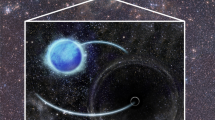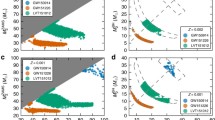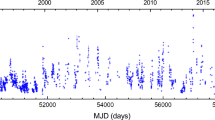Abstract
We present updated observations of the blazar PG 1553+113, a bright BL Lac Object that yields quasi-periodic gamma-ray emission every 2.2 years, strongly suggesting the activity of a super-massive binary black hole. Such binary systems are widely held to emit low-frequency gravitational waves. Confirming the binary nature of PG 1553+113 is very relevant for upcoming searches of nHz gravitational waves.



Similar content being viewed by others
References
Ackermann M, Ajello M, Albert A et al (2015) ApJL 813:41 (A15)
Barack L, Cardoso V, Nissanke S et al (2019) Class Quantum Gravity 36:14
Cavaliere A, Tavani M, Vittorini V (2017) ApJ 836:220
Celotti A, Ghisellini G (2008) MNRAS 385:283
Janssen G, Hobbs G, McLaughlin M, et al (2015) AASKA14 Proceedings, id. 37, http://pos.sissa.it/cgi-bin/reader/conf.cgi?confid=215
Kormendy J, Ho LC (2013) ARA&A 51:511
Tavani M, Cavaliere A, Munar-Adrover P, Argan A (2018) ApJ 854:11
Urry CM, Padovani P (1995) PASP 107:803
Author information
Authors and Affiliations
Corresponding author
Ethics declarations
Conflict of interest
The authors of this article confirm that the present manuscript follows the ethical responsibilities for authors stated by the journal. The authors also confirm that there are no conflicts of interest of any kind regarding the present manuscript.
Additional information
Publisher's Note
Springer Nature remains neutral with regard to jurisdictional claims in published maps and institutional affiliations.
This paper is the peer-reviewed version of a contribution selected among those presented at the Conference on Gamma-Ray Astrophysics with the AGILE Satellite held at Accademia Nazionale dei Lincei and Agenzia Spaziale Italiana, Rome on December 11-13, 2017.
Rights and permissions
About this article
Cite this article
Munar-Adrover, P., Tavani, M., Cavaliere, A. et al. The BL Lac PG 1553+113: a supermassive binary black hole candidate. Rend. Fis. Acc. Lincei 30 (Suppl 1), 145–148 (2019). https://doi.org/10.1007/s12210-019-00816-6
Received:
Accepted:
Published:
Issue Date:
DOI: https://doi.org/10.1007/s12210-019-00816-6




